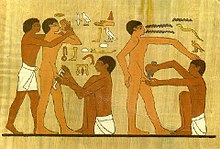Circumcision in Ancient Egypt
Male circumcision in ancient Egypt refers to the traditional removal of the penile foreskin in ancient Egypt .
history
The origin of this tradition, practiced in many regions, is unclear. According to American historian David L. Gollaher, circumcision on the penis was common early on in areas such as Africa, the Middle East, and Australia ( Aborigines ). Circumcisions were performed by priests with a stone blade in a public ceremony.
The oldest artistic representation of circumcision comes from ancient Egypt : priests celebrate a circumcision on a relief in the mastaba of Ankhmahor, vizier of Pharaoh Teti II , in Saqqara (around 2300 BC).
The origins of circumcision in Egypt are associated with, among other things, the Egyptian snake cult : the snake was considered immortal because it shed its skin and was thus able to renew itself again and again. Some cultural historians suspect that the circumcision of a man was supposed to symbolically trace the skin of the snake and make the human soul immortal.
According to the ancient Greek historian Herodotus (5th century BC), the Egyptians practiced "circumcision for reasons of purity ..." David L. Gollaher suspects that circumcision in ancient Egypt was a sign of the transition from childhood to Adulthood ( rite of passage ). He mentions that body alteration and the ritual of circumcision should give access to ancient mysteries that were reserved only for the initiated. The content of the mysteries is unclear, they are probably myths, prayers and incantations with central importance for the ancient Egyptian religion .
According to the Egyptian Book of the Dead , the sun god Ra "cut" himself, with the blood creating two small guardian deities. The French Egyptologist Emmanuel de Rougé interpreted this as an act of circumcision.
Research on Egyptian mummies shows that circumcision was common among adult men. For example, in a sample of 15 mummies of adult male individuals from al-Qurna , which date to the period between the 18th dynasty and the Greco-Roman period , the foreskin was completely removed in all cases, whereas this was not in all three examined child mummies was the case. Even with almost all preserved royal mummies, provided that genitals are not z. B. were damaged by grave robbers, circumcision could be determined - the only certain exception is Ahmose I , while with his successor Amenhotep I the results of the investigation were inconclusive.
present
Circumcision ( Arabic ختان Chitan orختنةChatna) is still practiced throughout Egypt today, by all religions and social classes. Muslims , Jews and Coptic Christians continue to practice circumcision for religious, traditional or hygienic reasons. The Oriental Orthodox churches related to the Coptic Orthodox Church such as the Ethiopian Orthodox Tewahedo Church and the Eritrean Orthodox Tewahedo Church do the same.
Web links
Individual evidence
- ↑ [1]
- ↑ [2]
- ↑ [3]
- ↑ David L. Gollaher: History of Circumcision
- ↑ Andreas Nerlich: Archaeomedicine: Surgery in ancient Egypt . In: Spectrum of Science , 2/2002 (February 1, 2002)
- ↑ Iwataro Morimoto: External genital organ in Male Mummies from Qurna, Egypt . In: Journal of the Anthropological Society of Nippon, 2/1989
- ^ Paula Vieira: To prevent, treat and cure love in ancient Egypt. Aspects of sexual medicine and practice in ancient Egypt .
